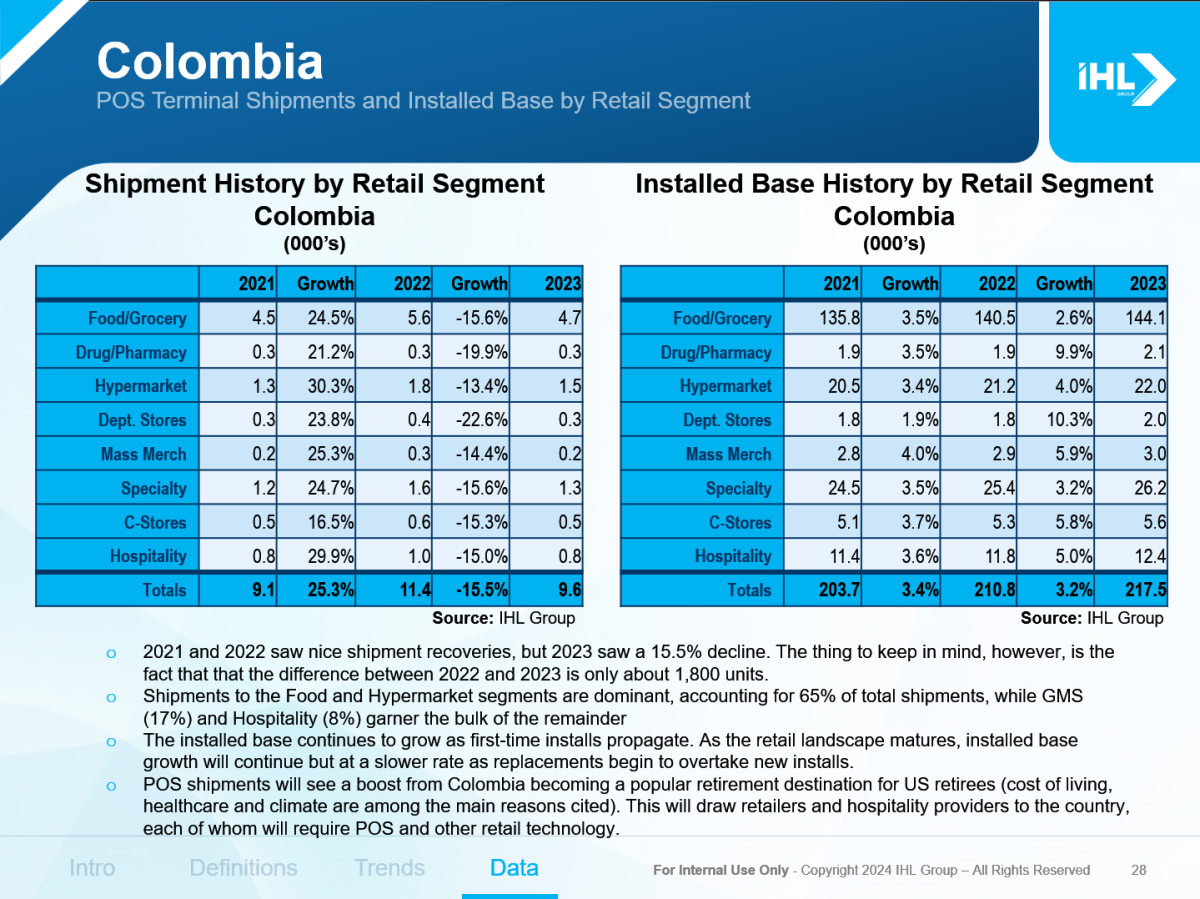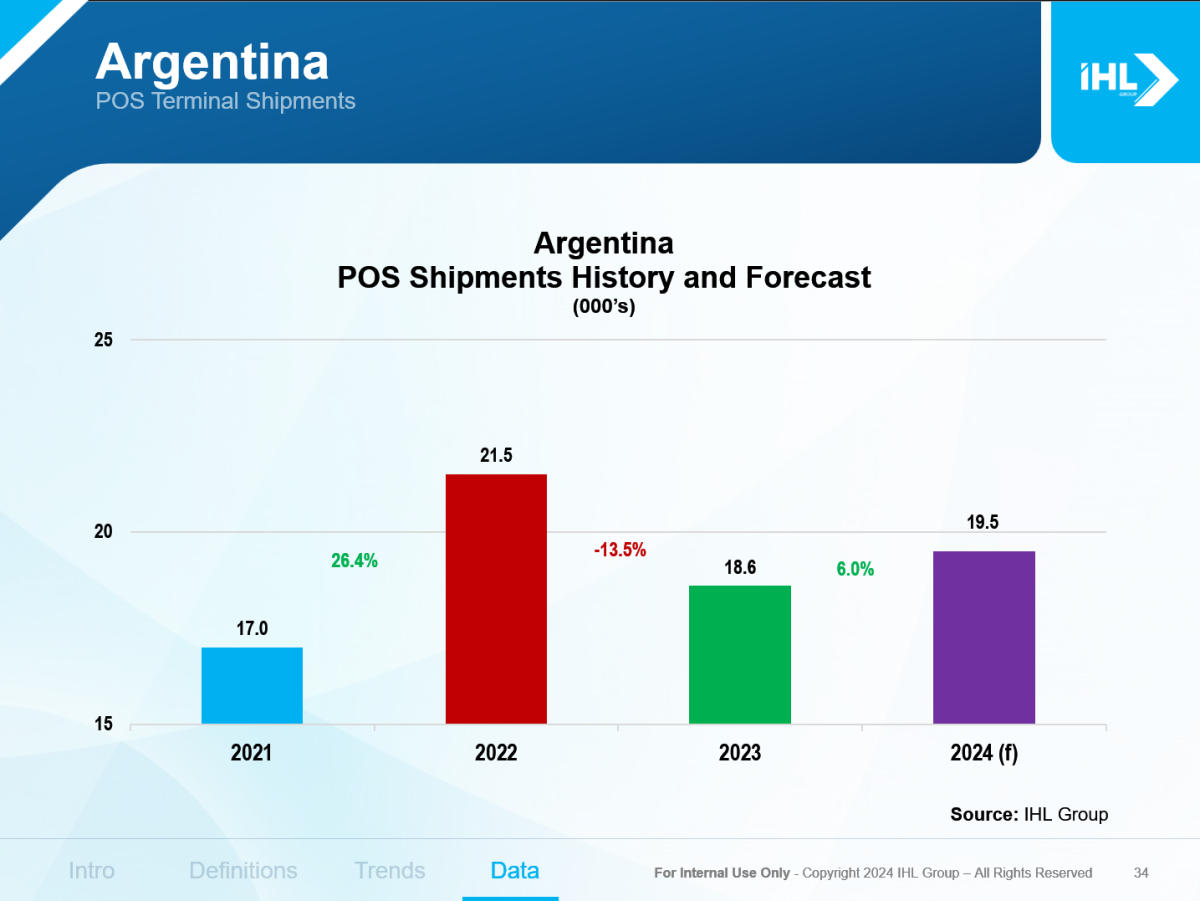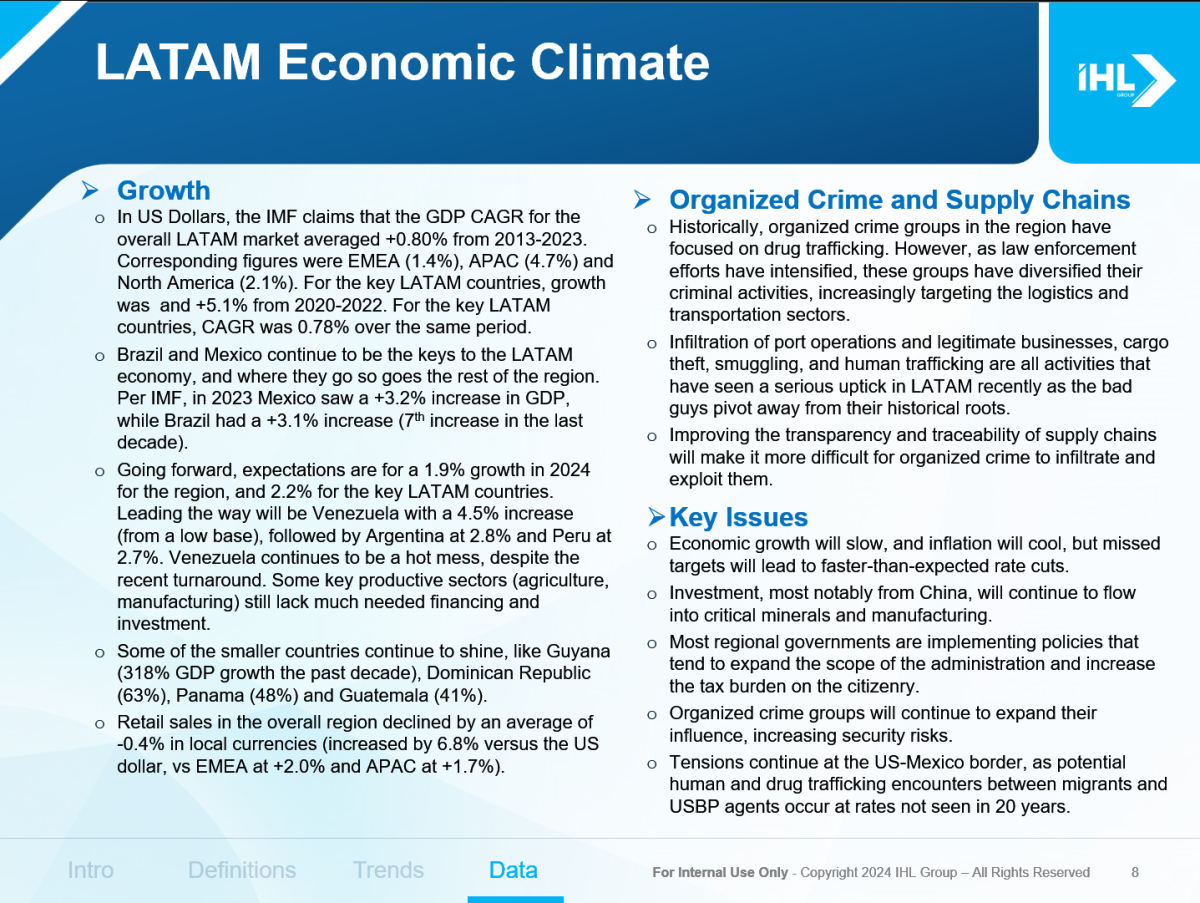Latin/South America POS Terminal Study – 2024
PRODUCT OVERVIEW
Our Latin America and South America Point-of-Sale (POS) Terminal Market Study – 2024 is 57 pages in length and has 22 figures. It explores the market climate for POS terminals throughout the Latin/Central and South American region.
More than just numbers without explanation, this report goes deep into discussion of retailing in the countries and segments to reveal the forces that are shaping POS purchase decisions. We believe it is important for our customers to not only see numbers but understand the market behind the data so as to make more informed decisions for the future. The Latan America and South America Point-of-Sale (POS) Terminal Market Study includes country-by-country shipments, installed base, forecasts and trends for the electronic point-of-sale terminal market in LATAM. Note that this is not a vendor market share report, but rather a fresh look at the state of POS technology in the world’s fastest growing market.
Additionally, the Latin America and South America Point-of-Sale (POS) Terminal Market Study covers emerging trends and influences that affected the market in 2024 and those that will help form market decisions in the future. It also includes estimated market value for shipments and installed base and a forecast for shipments and installed base through 2027.
Along with the general retail environment for each county/region, we discuss the country-by-country shipments, installed base, and forecasts for the following retail market segments:
- Food/Supermarket: Stores that sell food and grocery items and have between 4-20 terminals per store.
- Drug Stores/Pharmacy: Stores that sell personal care and medicinal items and have 2-5 terminals per store.
- Hypermarkets: This is a broad segment that varies by country. In many, it includes a full-service Food store as well as products typically included at Discounters under one roof. In other countries, stores can range anywhere from a Superstore format (think Wal-Mart Supercenter) to a full-line Department Store (with large appliances) combined with a full-line Grocery store.
- Department Stores: Traditionally larger format stores, upscale in products and including hard and soft goods with department style checkout.
- Mass Merchants: Like a Hypermarket format, only carrying non-food items or limited food items and using a front-end checkout. Also includes Discounters.
- Specialty Stores: Stores that focus on particular product line niches. Includes apparel, news, shoes, and DIY type stores.
- Convenience/Gas: Stores selling a limited variety of food and pharmaceutical items; open long hours for the convenience of customers.
- Hospitality: Includes Restaurants, Bars, Pubs and Hotels.
Testimonial:
Whenever I think of POS the first company that comes to mind is IHL Group. But IHL is so much more than just POS. The depth and breadth of IHL’s studies, databases, tools and fields of expertise grows each year and I look forward to taking full advantage of each and every one of them. – Joe Skorupa, Group Editor RIS News.
Related Studies:
Related Studies include the following:
- North American POS Terminal Market Study – 2024
- Europe/Middle East/Africa POS Terminal Study – 2024
- Asia/Pacific POS Terminal Study – 2024
- Latin/South America (LATAM) POS Terminal Study – 2024
- Asia/Pacific (APAC) Point-of-Sale (POS) Market Share – Hardware – 2024
- Asia/Pacific (Mobile POS) Market Share – Hardware – 2024
- Asia/Pacific Retail Store Location Chain Sizing with POS/mPOS – 2024
HIGHLIGHTS
Table of Contents
INTRODUCTION
Introduction
Market Segment Definitions
POS Definitions Used
Country Details
- POS-Related Trends in LATAM Retail
- Latin America Market Overview
- Mexico
3.1 Retail Overview
3.2 POS Shipments History and Forecast
3.3 POS Installed Base History and Forecast
- Brazil
4.1 Retail Overview
4.2 POS Shipments History and Forecast
4.3 POS Installed Base History and Forecast
- Colombia
5.1 Retail Overview
5.2 POS Shipments History and Forecast
5.3 POS Installed Base History and Forecast
- Chile
6.1 Retail Overview
6.2 POS Shipments History and Forecast
6.3 POS Installed Base History and Forecast
- Argentina
7.1 Retail Overview
7.2 POS Shipments History and Forecast
7.3 POS Installed Base History and Forecast
- Peru
8.1 Retail Overview
8.2 POS Shipments History and Forecast
8.3 POS Installed Base History and Forecast
- Venezuela
9.1 Retail Overview
9.2 POS Shipments History and Forecast
9.3 POS Installed Base History and Forecast
- Other Latin America
10.1 Retail Overview
10.2 POS Shipments History and Forecast
10.3 POS Installed Base History and Forecast
- Summary Tables
11.1 Historical Shipments by Segment
11.2 Historical Installed Base by Segment
- Forecasts
12.1 Forecast Shipments by Segment from 2023 – 2028
12.2 Forecast Installed Base by Segment from 2023 – 2028
- References
List of Figures
Figure 1 POS Shipment History and Forecast
Figure 2 POS Installed Base History and Forecast
Figure 3 Mexico POS Shipment History and Forecast
Figure 4 Mexico POS Installed Base History and Forecast
Figure 5 Brazil POS Shipment History and Forecast
Figure 6 Brazil POS Installed Base History and Forecast
Figure 7 Colombia POS Shipment History and Forecast
Figure 8 Colombia POS Installed Base History and Forecast
Figure 9 Chile POS Shipment History and Forecast
Figure 10 Chile POS Installed Base History and Forecast
Figure 11 Argentina POS Shipment History and Forecast
Figure 12 Argentina POS Installed Base History and Forecast
Figure 13 Peru POS Shipment History and Forecast
Figure 14 Peru POS Installed Base History and Forecast
Figure 15 Venezuela POS Shipment History and Forecast
Figure 16 Venezuela POS Installed Base History and Forecast
Figure 17 Other LATAM POS Shipment History and Forecast
Figure 18 Other LATAM POS Installed Base History and Forecast
Figure 19 Historical Shipments by Segment
Figure 20 Historical Installed base by Segment
Figure 21 Forecast Shipments by Segment thru 2028
Figure 22 Forecast Installed Base by Segment thru 2028
PREVIEW
Click on a thumbnail to expand.



FAQs
Latin America EPOS Definitions
At IHL we believe it is important that we state clearly the definitions of what we are classifying as a POS device. For the purposes of our analysis, we are defining POS as PC-based workstations, namely PC-class Processor-based and LAN-available terminals. Although others might include Electronic Funds Terminals as POS, we do not include them here.
In our research, we do include PC on Cash Drawer Devices (PCOCD), however, we do not attempt to distinguish between vendors unless a particular market is affected significantly.
We do not include Electronic Cash Registers (ECR’s) in our study. Although the lines have blurred as to POS and ECR in terms of processors and connectivity, we believe there is a clear distinction in functionality, expandability, and serviceability between the devices.
As this report also looks at market segment information, it is important that we distinguish the types of institutions we include in each market segment. These are the following:
Food/Supermarket: Stores that sell food and grocery items and have between 4-20 terminals per store.
Drug Stores/Pharmacy: Stores that sell personal care and medicinal items and have 2-5 terminals per store.
Hypermarkets: This is a broad segment that varies by country. In many, it includes a full service Food store as well as products typically included at Discounters under one roof. In other countries, stores can range anywhere from a Superstore format (think Wal-Mart Supercenter) to a full-line Department Store (with large appliances) combined with a full-line Grocery store.
Department Stores: Traditionally larger format stores, upscale in products and including hard and soft goods with department style checkout.
Mass Merchandisers: Like a Hypermarket format, only carrying non-food items or limited food items and using a front-end checkout. Also includes Discounters.
Specialty Stores: Stores that focus on particular product line niches. Includes apparel, news, shoes, and DIY type stores.
Hospitality: Includes Restaurants, Bars, Pubs, Hotels, and Convenience Store outlets.
Isn’t Mexico part of North America?
For geography lessons, yes. However, when vendors and retailers look at the world they tend to lump Mexico – a Spanish speaking country – with the other countries that share the language in the region. While some might argue that California, Arizona, New Mexico, Texas and Florida could also be included based on that definition, our vendor clients are all united in keeping them part of our North American study.
Can I share this study in my company?
Yes, each of research products come with an enterprise license so it is free for anyone internal to your organization. See below for more.
Can I share this study with partners and clients?
Not in entirety unless you have negotiated a distribution license with IHL. Basically we don’t want the study going to partners and clients who should otherwise purchase a license. This is what we do for a living, and if people violate this we can no longer do the research. Contact us at ihl(at)ihlservices.com with any questions.
Can I quote this study in my presentations and press releases?
In most cases this is fine but we ask that you run it by us first at ihl(at)ihlservices.com. Typically things shared in percentages (ie. this is 20% increase) then that is fine. Items in raw $$$ or units typically we will not allow to share. But we can work with you on this. We realize that you buy the research to use, so we can usually find a nice compromise that protects our IP and meets your needs.
Was this a survey or a paper?
A little of both. When it comes to this sort of impact study it is part art and science. We have several primary research studies behind the numbers. These are then extrapolated across segments and markets to provide overall sizing. We run this by key clients and other analysts for their insight and view as well before we release. So the cornerstone is detailed primary research data with CIOs meshed with numerous analysts with over 100 combined years of retail sizing experience to build the models.
Is more detail available beyond what is in the study?
Yes, indeed. We have an extremely detailed Retail WorldView IT Sizing model that allows us to look at over 300 technologies across every region of the world by segment. So we can customize the research output just for your needs. Simply contact us at ihl(at)ihlservices.com or +1.615-591-2955
Can I get access to the analysts who wrote or partnered in the study?
Yes, one of the core differentiators of IHL Research Studies is that included in part of the price is up to 1 hour with the analyst to ask follow-up questions or dig further into any assumptions. This does not extend to getting more data, just better insight into how we arrived at the data and came to the conclusions from that data.
PRICING
License Options
Enterprise License – a license that allows for the research to be accessed and shared internally with anyone else within the organization and wholly owned subsidiaries.
IHL Group License and Fair Use Agreement
All of IHL Group’s generally available research are electronic licenses and are limited by the license type chosen for purchase. For Single User Licenses this means that the person buying the research is the only person to use the research.
For Enterprise Licenses, these can be shared freely within the company. We only ask that this information not be shared with partners or others outside the purchasing company without authorization from IHL Group. The license does not extend to joint ventures or other partnerships. If the relationship is not a wholly-owned subsidiary, then both parties would need a license.
Practically, this implies the following:
- The purchasing company can use the data and research worldwide internally as long as the international organizations are wholly owned subsidiaries of the purchasing company.
- The data or any research cannot be distributed in whole or in part to partners or customers without express written approval from IHL Group.
- The purchasing company may quote components of the data (limited use) in presentations to customers such as specific charts. This is limited to percentage components, not individual unit information. Unit data cannot be shared externally without express written approval from IHL Group. All references to the data in presentations should include credit to IHL Group for the data.
- The purchasing company can reference qualitative quotes in printed material with written approval from IHL Group.
- All requests requiring written approval should be submitted to ihl(at)ihlservices.com and will be reviewed within one business day.
For Distributed Licenses, if applicable, the research can be shared with prospective customers and potential institutional investors. It cannot be shared with partners or other vendors who should be purchasing their own licenses.
For any questions regarding this policy, please contact us at 1-888-IHL-6777 (North America) +1.615.591.2955 (International) or email us at ihl(at)ihlservices.com.

